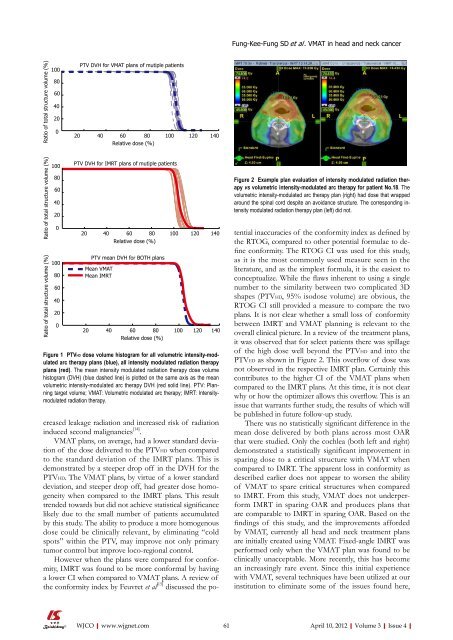World Journal of Clinical Oncology
World Journal of Clinical Oncology
World Journal of Clinical Oncology
You also want an ePaper? Increase the reach of your titles
YUMPU automatically turns print PDFs into web optimized ePapers that Google loves.
Ratio <strong>of</strong> total structure volume (%)<br />
Ratio <strong>of</strong> total structure volume (%)<br />
Ratio <strong>of</strong> total structure volume (%)<br />
100<br />
80<br />
60<br />
40<br />
20<br />
0<br />
100<br />
80<br />
60<br />
40<br />
20<br />
0<br />
100<br />
80<br />
60<br />
40<br />
20<br />
0<br />
PTV DVH for VMAT plans <strong>of</strong> mutiple patients<br />
20 40 60 80 100 120 140<br />
Relative dose (%)<br />
PTV DVH for IMRT plans <strong>of</strong> mutiple patients<br />
20 40 60 80 100 120 140<br />
Relative dose (%)<br />
PTV mean DVH for BOTH plans<br />
Mean VMAT<br />
Mean IMRT<br />
20 40 60 80 100 120 140<br />
Relative dose (%)<br />
Figure 1 PTVHD dose volume histogram for all volumetric intensity-modulated<br />
arc therapy plans (blue), all intensity modulated radiation therapy<br />
plans (red). The mean intensity modulated radiation therapy dose volume<br />
histogram (DVH) (blue dashed line) is plotted on the same axis as the mean<br />
volumetric intensity-modulated arc therapy DVH (red solid line). PTV: Planning<br />
target volume; VMAT: Volumetric modulated arc therapy; IMRT: Intensitymodulated<br />
radiation therapy.<br />
creased leakage radiation and increased risk <strong>of</strong> radiation<br />
induced second malignancies [14] .<br />
VMAT plans, on average, had a lower standard deviation<br />
<strong>of</strong> the dose delivered to the PTVHD when compared<br />
to the standard deviation <strong>of</strong> the IMRT plans. This is<br />
demonstrated by a steeper drop <strong>of</strong>f in the DVH for the<br />
PTVHD. The VMAT plans, by virtue <strong>of</strong> a lower standard<br />
deviation, and steeper drop <strong>of</strong>f, had greater dose homogeneity<br />
when compared to the IMRT plans. This result<br />
trended towards but did not achieve statistical significance<br />
likely due to the small number <strong>of</strong> patients accumulated<br />
by this study. The ability to produce a more homogenous<br />
dose could be clinically relevant, by eliminating “cold<br />
spots” within the PTV, may improve not only primary<br />
tumor control but improve loco-regional control.<br />
However when the plans were compared for conformity,<br />
IMRT was found to be more conformal by having<br />
a lower CI when compared to VMAT plans. A review <strong>of</strong><br />
the conformity index by Feuvret et al [15] discussed the po-<br />
WJCO|www.wjgnet.com<br />
Fung-Kee-Fung SD et al . VMAT in head and neck cancer<br />
Figure 2 Example plan evaluation <strong>of</strong> intensity modulated radiation therapy<br />
vs volumetric intensity-modulated arc therapy for patient No.18. The<br />
volumetric intensity-modulated arc therapy plan (right) had dose that wrapped<br />
around the spinal cord despite an avoidance structure. The corresponding intensity<br />
modulated radiation therapy plan (left) did not.<br />
tential inaccuracies <strong>of</strong> the conformity index as defined by<br />
the RTOG, compared to other potential formulae to define<br />
conformity. The RTOG CI was used for this study,<br />
as it is the most commonly used measure seen in the<br />
literature, and as the simplest formula, it is the easiest to<br />
conceptualize. While the flaws inherent to using a single<br />
number to the similarity between two complicated 3D<br />
shapes (PTVHD, 95% isodose volume) are obvious, the<br />
RTOG CI still provided a measure to compare the two<br />
plans. It is not clear whether a small loss <strong>of</strong> conformity<br />
between IMRT and VMAT planning is relevant to the<br />
overall clinical picture. In a review <strong>of</strong> the treatment plans,<br />
it was observed that for select patients there was spillage<br />
<strong>of</strong> the high dose well beyond the PTVHD and into the<br />
PTVED as shown in Figure 2. This overflow <strong>of</strong> dose was<br />
not observed in the respective IMRT plan. Certainly this<br />
contributes to the higher CI <strong>of</strong> the VMAT plans when<br />
compared to the IMRT plans. At this time, it is not clear<br />
why or how the optimizer allows this overflow. This is an<br />
issue that warrants further study, the results <strong>of</strong> which will<br />
be published in future follow-up study.<br />
There was no statistically significant difference in the<br />
mean dose delivered by both plans across most OAR<br />
that were studied. Only the cochlea (both left and right)<br />
demonstrated a statistically significant improvement in<br />
sparing dose to a critical structure with VMAT when<br />
compared to IMRT. The apparent loss in conformity as<br />
described earlier does not appear to worsen the ability<br />
<strong>of</strong> VMAT to spare critical structures when compared<br />
to IMRT. From this study, VMAT does not underperform<br />
IMRT in sparing OAR and produces plans that<br />
are comparable to IMRT in sparing OAR. Based on the<br />
findings <strong>of</strong> this study, and the improvements afforded<br />
by VMAT, currently all head and neck treatment plans<br />
are initially created using VMAT. Fixed-angle IMRT was<br />
performed only when the VMAT plan was found to be<br />
clinically unacceptable. More recently, this has become<br />
an increasingly rare event. Since this initial experience<br />
with VMAT, several techniques have been utilized at our<br />
institution to eliminate some <strong>of</strong> the issues found here,<br />
61 April 10, 2012|Volume 3|Issue 4|

















